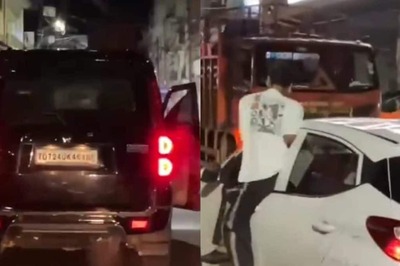
views
How to Tie a Runner’s Knot
Lace your shoes, leaving the top eyelets open. The very top eyelets on running shoes are usually off to the side of the eyelets second from the top. They’re off-set to allow you to lace them with the runner’s knot. The placement helps pull the top of the shoe tighter to the heel when it’s laced. If your shoes are already laced up, you don’t have to re-lace them as long as the shoelaces are laced from the inside out in the second-to-top eyelet. Standard criss-cross lacing is the most common lacing style. It crisscrosses the shoelaces as you thread through the eyelets. There are additional running shoe lacings that help address common fit issues like incorrect foot width.
Make a loop by lacing the shoelace through the top eyelet. Feed the left shoelace down through the off-set eyelet on the same side of the shoe to make a loop. Don’t pull it tight yet. Repeat on the opposite side by feeding the right shoelace down through the top-right eyelet.
Cross the shoelaces over and thread them through the opposite loops. Cross the left shoelace to the loop on the right side of the shoe. Thread the end of the shoelace through the loop from the inside out. Repeat on the opposite side by threading the right shoelace through the loop on the left side.
Pull both shoelaces tight and tie them in a knot to secure your shoes. Pull on the shoelaces at the same time to tighten the loops flat against the shoe. Then, tie the laces in a secure knot and you're all set for your run!
Runner’s Knot Benefits
A runner’s knot locks your heel into the shoe to prevent slipping. Not only does the runner’s knot make your shoe feel more secure on your foot, but it also helps to minimize the wear and tear on the back of your shoe. Always start by choosing a running shoe that fits your foot to help prevent injuries and keep your feet healthy. Because a runner’s knot only tightens the collar of your shoe, you don’t have to try to squeeze your foot into a smaller shoe size to get a more secure fit. The runner’s knot is also called a Heel Lock Knot, Lace Lock, or Runner’s Loop.
Tying runner’s knots in your shoelaces helps prevent blisters. As your foot sweats and your shoe moves around on your foot during a run, it creates friction. Excess friction is one of the main causes of blisters from shoes. Customizing the fit of your running shoes with a runner’s knot helps to hold the shoe in place. To prevent blisters, wear socks made of moisture-wicking fabric and apply athletic tape to your heel and other blister-prone spots before your run.
Runner’s knots provide more ankle support. Because this knot pulls the shoe’s collar tight and prevents your heel from slipping around in the shoe, it helps keep your ankle straight as you run. A secure shoe is less likely to cause your ankle to twist or roll, which causes your ankle ligaments to stretch too far or even tear, resulting in a sprain. If you’re prone to ankle sprains or are recovering from a sprain, you may need more support than a runner’s knot can provide. Wrapping your ankle with athletic tape or wearing soft ankle braces provides more support for weak and healing ankles.
Other Secure Shoelace Knots
Reef Knot Cross your shoelaces to make an X. Wind the top lace around the bottom and thread it through the gap under the crossed laces. Pull the ends of both shoelaces tight to make the starting knot. Then, make a loop with the left shoelace and wrap the right shoelace around the base of the loop. Instead of wrapping the lace over the top of the loop as with a standard shoelace bow, wrap it under the loop and then over the top to make a more secure knot. For an alternate secure knot called the Better Bow Knot, wrap the shoelace over the top of the first loop twice instead of once. Make a second loop by pulling the shoelace below the first loop. Hold both loops and pull them tight.
Double Slip Knot Make a starting knot by crossing the shoelaces and then wrapping the top lace around the bottom one. Feed the end of the shoelace through the gap below the crossed laces. Pull the ends to make it tight. Create a loop with each shoelace so you have “bunny ears.” Cross the loops and then wrap the back loop around to the front. Push the loop through the gap below the crossed loops from front to back. Don’t pull it tight yet. Wrap the opposite loop around to the back and push it through the gap beneath the laces from back to front. Pull both loops to tighten the knot.
Surgeon’s Shoelace Knot Cross the shoelaces, wrap the top lace around to the back, and push the end through the gap below the crossed laces. Pull both shoelaces tight. Make a loop with the right shoelace. Wrap the left lace all the way around the back of the loop, ending in the front. Create a loop with the same shoelace and push it through the gap below the wrapped base of the loop, but don’t pull it tight yet. Push the loop through the gap toward the back of the knot. Wrap the loop from back to front and feed it through the gap a second time. Pull both laces tight to secure the knot.
Relieving Pressure with Window Lacing
Unlace your shoes to the eyelet below where your foot hurts. Starting with your shoes already laced up and on your feet, find the spot on the top of your foot that rubs against your shoe. Unlace the shoe to the set of eyelets just below the painful spot by pulling the ends of the shoelaces out of the eyelets. Starting with your shoes already laced and on your feet helps you find the exact spot where your shoe causes pain.
Re-lace the shoelaces down into the eyelets directly above them. Instead of crisscrossing your shoelaces, create a window in the pattern by feeding the shoelaces into the next open eyelets without crossing the shoe. Feed the left shoelace from the outside into the eyelet directly above it. Then, repeat on the other side by feeding the right shoelace into the next open eyelet above it. By leaving a “window” over the painful spot, you put less pressure on the area, which helps lessen the irritation.
Cross the shoelaces and thread them through the next open eyelets. Finish re-lacing the shoe by crossing the left shoelace over to the eyelet on the opposite side of the shoe. Thread it up through the next open eyelet. Repeat by feeding the right shoelace into the next open eyelet on the right side. Repeat the process by crossing the laces over to the next available eyelets until you reach the top of the shoe.




















Comments
0 comment